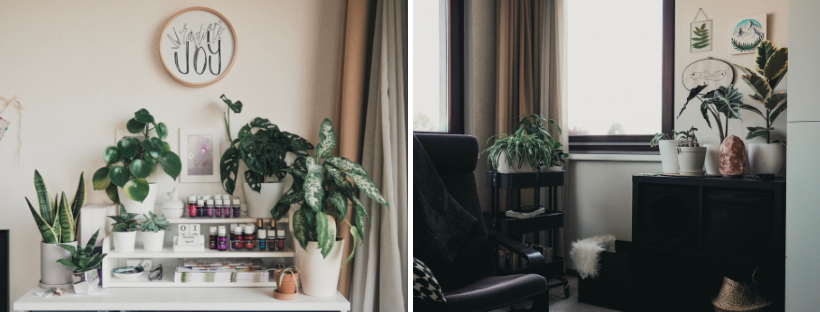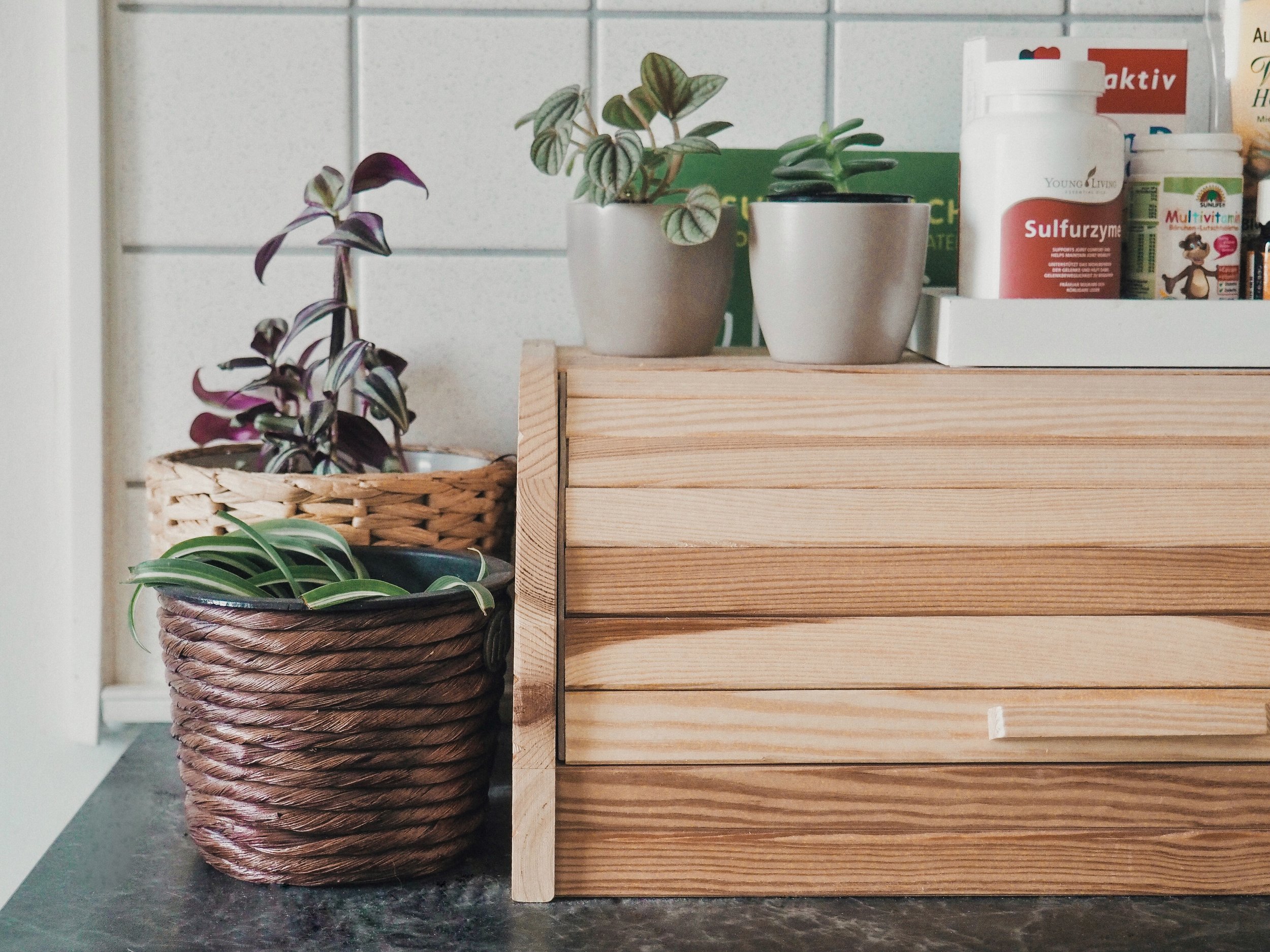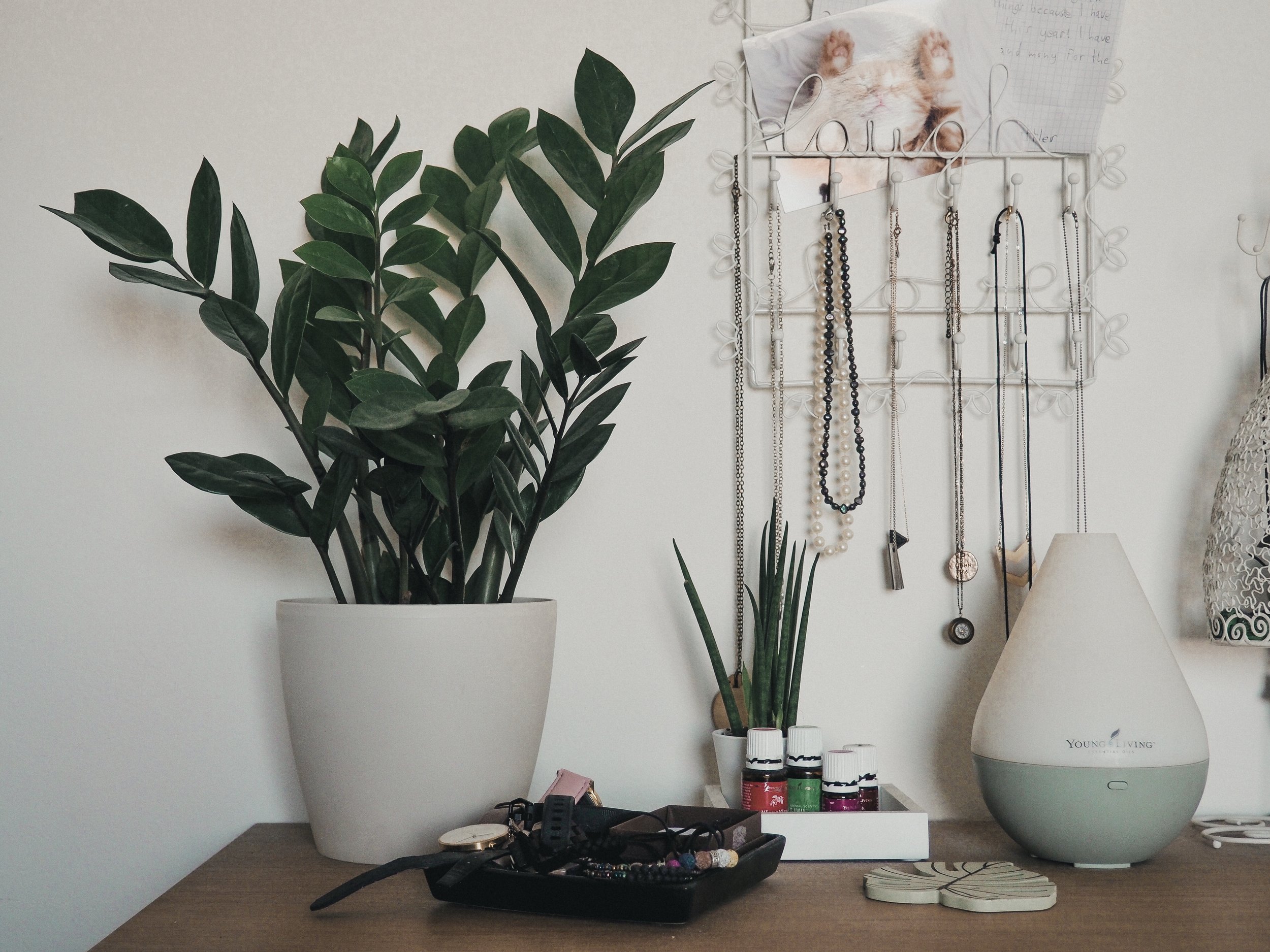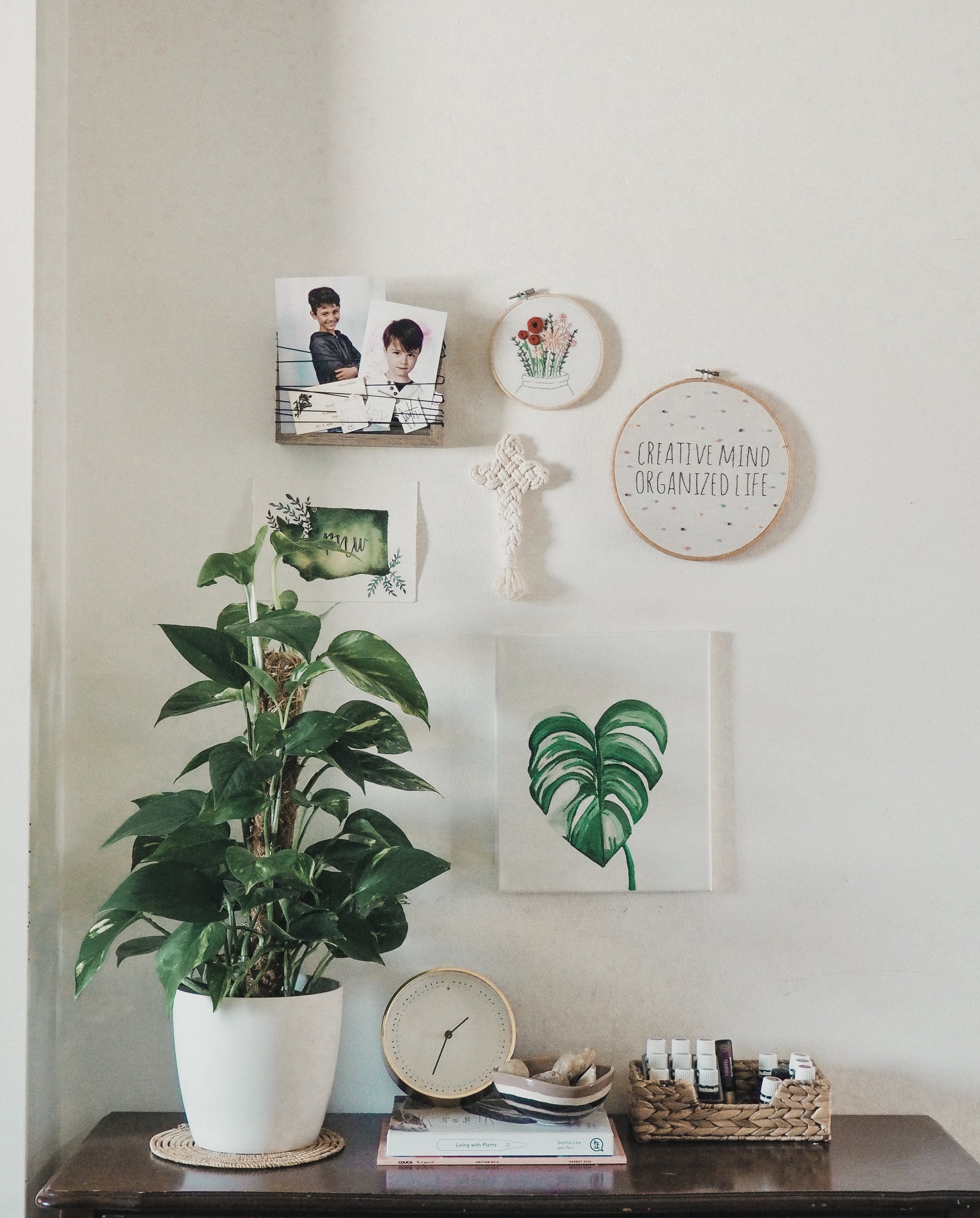What I've Learned in My First Year as a Plant Mom | Tips on Indoor Plant Care
I have been a "plant mom" for one year, as of this month. [Hold for applause.] While I'll admit that in the course of this past year, I have lost a couple of plants here and there due to natural causes, my emerging green thumbs have come so far. As of right now, I have 34 plants who seem to be very happy with their planty little lives.
There's a lot I still have yet to learn, but I thought it would be fun to share with you some of the things I've learned so far on this #plantmom journey, and to give you a little photo tour of my greenhouse. Um, I mean my apartment.
Before we begin, here's my disclaimer, and a story of hope for you, if you think you're a no-good-plant-murderer:
I started as a complete newb. I couldn't keep anything alive – not even the succulents and cacti that Instagram would have us all believe are the easiest living things to care for. First of all, I am here to tell you that that is a lie from the devil, and when you feel like a loser because you can't keep your succulent alive, you need to put your foot down and say "not today, Satan," because succulents are not immortal.
But after killing several succulents and cacti, and even a couple of leafy plants that in theory should have been easy enough to take care of, which my plant-expert-friend gave me, did I give up? NO. I did not give up. [Cue the motivational music.]
My friend didn't give up on me, either. She was sympathetic and encouraging, and the next time she came to visit she brought me another plant – what I believe to be Devil's Ivy (Epipremnum aureum) (how quaint. and ironic.). I showed her where I wanted to keep it – in my kitchen, near the sink – and she confirmed that it would be the perfect spot. She showed me how much water to give it (which was way more than I would have given it if left to my own devices), and told me to water it every week or so.
After some more encouragement and advice from my friend, I was even more determined to keep more plants alive, so went to a local nursery and picked up a small collection: my original #plantfam. That day, I brought home a Spider Plant (Chlorophytum comosum), a Dumb Cane (Dieffenbachia), a Wolverine Hosta (yes, for indoors!, because I know nothing), and a Wandering Jew (Tradescantia zebrina). I also picked up a hot pink Bromeliad from a grocery store. I won't go into the order of the rest of the plants I've gotten since then, but I'll say this: except for the Bromeliad (because she lived her hot pink life, produced babies, then died a beautiful death), all the original clan are still alive and well, and are very near and dear to my heart.
Now as I said, there has been the occasional plant memorial service in the past year, because I'm still learning and sometimes buy the wrong plant, but I can say that I'm more-or-less a successful plant mom, at this point. So, how did I do it?
It's simple.
What I've Learned in My First Year as a Plant Mom
Things to Consider
What's the Sitch? Notice in the above paragraph, I said I "sometimes buy the wrong plant." What I mean is that I've gotten smarter about which plants will work in our home, whether it's because of how our apartment is situated, or because I know I don't have the ideal conditions for a particular plant to thrive. Also, we have two cats now, and a lot of plants don't do well with curious cats (and vice versa). I do a lot of speed-googling while I plant shop, and never buy unless I'm sure the plant is going to be okay in our home.
Where are Your Windows? We have two windows facing NW and three windows facing NE. The NW windows are killers; however, I can assume that most plants I buy will be more or less okay if I place them in the rooms with the NE-facing windows. Some of the plants like a bit of direct sunlight now and then, but most of them like indirect sunlight, which means the curtains are closed in the mornings until the sun has risen a bit higher. (We have a thin, cream-colored curtain that allows light in, but still blocks the sun, so that's the one I'm referring to. We don't live in a cave.)
Does Your Plant Need a Friend? This was something I learned by accident. Some leafier plants need quite a bit of humidity, and one way to increase humidity is to place a few plants together! Also consider the opposite (desert plants don't need a lot of friends/humidity), and consider the types of plants you're arranging together. One way to determine which plants will make good life partners is to notice what types of plants are placed together at the nursery you buy from. For instance, when I bought my Spider Plant, Wandering Jew, and Hosta, they were near each other at the nursery. They've been near each other ever since, and love life. Even when I propagate and plant new Spider Plants and Wandering Jews, I tend to place them together so they can grow up as buddies and pals.
Humidity is a Factor. Alright so I mentioned above that one way to increase humidity is to place plants together, but there are some other ways you can get more of a handle on the situation. Three other ways I increase humidity are to run a diffuser/humidifier pretty much all-the-live-long-day, to mist (most of) my plants about once a week, and I've even tried placing the more humid-loving plants near our bathroom door. Let's talk about it.
Diffusers/Humidifers. As for the diffusers/humidifiers, we actually have four of them in our home, because they're good for our health, as human beings. The one in our living room is the one that's usually going most often, which is where we spend most of our time as a family, and which happens to be the room with the most plants. I've tried experimenting to see if any of the plants grow more or less depending on which essential oils I choose to diffuse, but I haven't noticed a huge difference. They seem to love the diffuser/humidifier in general, and, like me, love all the oils. I will say that the two plants nearest the diffuser do seem to grow at a more rapid rate than any of the other plants in the room.
Misting. Some of the leafier, tropical plants need more attention, so I mist them about once a week (between waterings) with a DIY plant mist. Bugs tend to hate Peppermint and Citronella, and cats don't like citrus (we don't want our cats chewing on the plants), so I usually make a mixture using Peppermint, Citronella, and Orange or Lemon essential oils. I've also used Peppermint and Purification essential oils. So once you've chosen your essential oils, add the oils and some distilled water to a glass spray bottle, and mist your plants about once a week.
Misting Tips:
Make sure the essential oils you're using are completely pure. If they contain even a trace of synthetics, this could damage your plant. If you're not sure, it's better to leave the essential oils out of it and mist with straight water. I only use Young Living's essential oils. Here's why.
Don't use mineral water – the plants don't need added minerals because they're getting the minerals they need from their soil and from their waterings. Also, if you're misting their leaves, mineral water could leave spots. You can find distilled water pretty much anywhere. Look in the laundry detergent section or household cleaning section at your local store.
Assuming you're using pure essential oils in your misting spray, be sure to use a glass or stainless steel spray bottle. Pure essential oils will erode synthetic materials (this is a good thing, they're doing their job); you don't want to be spraying traces of plastic onto your beautiful plants!
Placement. Bathrooms get pretty humid. Sometimes a bit too humid if they don't have proper ventilation (major eye roll at the people who designed and built our apartment building). That said, if a bathroom has proper ventilation and a decent amount of natural light, it can make a brilliant home for some plants. (Ferns, for example.) Since our bathroom gets zero natural light because it doesn't have a window, I've placed a couple of plants in the hallway so they can feel some of the humidity that bursts through the door after a shower or bath, and can get some light from the windows in our bedrooms, at the ends of the hallway.
To Water or Not to Water? I've read and heard from different sources that having a watering schedule is good and helpful, and that having a watering schedule is a bad idea, because you may tend to over-water. So, I do both. Let me explain… Every Monday, I check the soil of each of my plants. (That's the "schedule" part.) I use the Knuckle Test or Knuckle Method. Sounds weird, I know, but for the past year it's worked for me. All I do is I go around to each plant and stick my finger in the soil, up to my second knuckle. That's about an inch and a half deep. If the soil is dry, I give it a good watering, and if it's still damp, I leave it alone until the next week. (That's the "no schedule" part, kind of, because I leave it up to the plant. I don't give them water every week unless they need it.) And that's it! In my experience it's much better to under-water than it is to over-water, so waiting a week for the damp soil to dry out has been working fine. Of course, I've gotten to know my plants better and have been learning as I go, so there are some adjustments I make here and there on the watering front; there are some plants that are thirsty all the time, and some who are good with being ignored for long periods of time. So check the soil before you water, consider the type of plant it is, and always, when in doubt, ask the plant experts (often found on Google).
Consider Your Source. This is something else I learned by accident. I won't get too snooty because every shop is different, but be aware of where you're purchasing your plants from. As you shop, notice where the plants are placed in the nursery or store, check their soil, check under their leaves for spots/mites/other random "flaws," and consider where you are, for a second. Are you at a nursery or home store? Are you at a furniture or department store? A grocery store? Is there someone on staff there whose main job is to care for the plants that the store is selling? – does someone on staff have a clue about how to care for plants? This isn't to inflate your ego (or mine). Just think – what if you have a question about a plant as you shop, but can't Google it on the spot or want a real human to help you out… is there going to be someone there who you'll be able to trust to give you good advice? I've learned the hard way not to buy living things from certain stores. Unfortunately, one of the only ways to learn where not to shop from is by experience.
It's the Circle of Life. (And it moves us all.) Finally, remember that plants are living things. They live in cycles, like we humans do. They grow things, they lose things, they flourish, and they rest. They also die. For instance, when one of your plants has yellowing or browning leaves, it could mean a handful of different things. It doesn't always mean that it's "on its way out." Take the initiative to do a little research on the plant that seems troubled, and consider where you have it placed, how often you've been watering it, how much humidity it's exposed to, etc. Check for bugs. Inspect its soil every once in a while too, and decide whether you need to fertilize it. With a little extra care, you might be able to save the plant. Or, you might not. And that's okay, too.
A Note on Yellow/Brown Leaves. The good news is that the plant may be dropping leaves to make room for new growth (this lesson is brought to you by my Dumb Cane). So, when you have yellowing or browning leaves, don't cut them off right away. Some plants feed off of the nutrients of their dying leaves, so it may be best to leave the ugly leaves on the plant until they're nice and crispy (when you know all the life has been drained out of them). Again though, the trick is to determine why the leaf is browning in the first place – is it just the circle of life, or is the plant not feeling alright? If the browning leaf is sick in some way, it's best to cut it off ASAP so the sickness doesn't spread to the other, healthy leaves.
That concludes the list of what I've learned in my first year as a plant mom. There are way too many aspects of a plant's circle of life for me to cover here though, and of course there are many factors, I'm sure, that I haven't even considered yet, as new to this as I am. So the best advice I can give you, in the end, is to Google, Google, Google, research, research, research, and ask your resident plant expert (that's not me, fyi). It is in your power to learn all you can about the plants that you have to be the best plant parent you can be. And remember, each plant is unique in its own way, so not all "rules" will apply to every plant.
You can do this. If you want to be a plant mom, you can be a plant mom.
Now, for the photo tour of our home. Not pictured are my Monstera, who's out in the apartment stairwell; my Orchid, who's "resting" (is a pile of brambles); and the plants and flowers in our window box.
The Living Room
The Kitchen
The Bedroom and Hallway
Annnnd, that's the fam! I'm so happy with my little plant family – we've been through so much together.
I hope this post has been encouraging and even a little helpful, and if nothing else, that you were able to enjoy some planty eye-candy.
What plants are on your plant fam wish list?
















